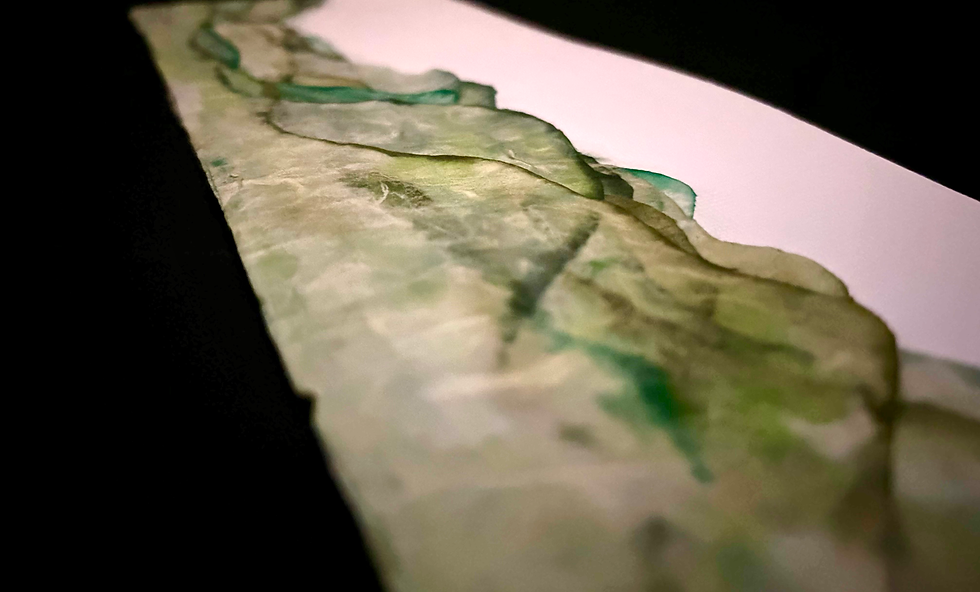

about.
Hi, I’m Katie Henderson, a visual artist based in South Wales. My practice sits where creativity, health, and lived experience meet. I’m especially passionate about the role of the arts in health and aspire to help shape creative, patient-led projects within NHS settings here in Wales.
Much of my work explores what it means to live with Type 1 diabetes, not only the medical facts, but also the emotional, physical, and psychological realities of the condition. Living with long-term complications, following difficult control during my teenage years, has left a lasting mark on me. At the same time, it has deepened my empathy for others navigating their own health journeys. Visual art has become a way for me to make sense of this experience, and I am drawn to how creativity can offer that same space for reflection, connection, and care to others. While diabetes guides much of my current work, I live with multiple chronic conditions and aim to explore these more fully in future projects and participant groups. That lived experience runs through everything I do, both in my own practice and when working alongside others.
Beyond making the work, I care about what it makes possible. I want it to open honest conversations about chronic illness, challenge assumptions, and create spaces where people feel seen and heard. For me, creativity is a tool for meaningful conversations, deeper understanding, and improved care.
I graduated with a BA (Hons) in Creative and Therapeutic Arts in 2023 and am currently studying for a Master’s in Arts Practice, focusing on Arts, Health and Wellbeing.

between the lines
DIABETES BEYOND THE NUMBERS
I am currently working on Between the Lines: Diabetes Beyond the Numbers, an arts and health project created as part of my MA in Arts Practice (Arts, Health and Wellbeing) at the University of South Wales. Installed in the Hummingbird Diabetes Centre (CTMUHB) waiting room, the work combines stitched glucose graphs with fluid alcohol inks to reflect both the structure and unpredictability of living with type 1 diabetes. Each piece is accompanied by a personal “Behind the Lines” reflection, and visitors are invited to share their own responses, with the hope that these shared experiences will help shape future participatory arts projects at the centre. My hope is that the work shines a brighter light on the complex, real, and sometimes overlooked experiences of living with diabetes, and helps others with the condition feel seen and less alone.


Describe your image

















the glucose diaries.
The Glucose Diaries was a project where I worked with a month’s worth of my glucose graphs. For many years I struggled with how I felt about my glucose levels, and even though my management is much better now than it was in my teens, I still find them difficult to deal with. For this project, I was keen to see if creativity and art-making could help me change the way I perceive those numbers. I experimented with different art mediums to explore whether working creatively could shift my attitude, and in the process I began to see my glucose patterns in a new light, reflect more deeply on my daily management, and make some positive changes in how I approach my diabetes. What I found was that creativity gave me a more compassionate perspective on my data, helping me move away from shame and towards understanding.

I re-traced my glucose data using carbon paper and fine liner. I was drawn to the idea of turning something clinical and numerical into something more organic, beautiful—even alive.



I re-traced my glucose data using carbon paper and fine liner. I was drawn to the idea of turning something clinical and numerical into something more organic, beautiful—even alive.

This stitching method helped me slow down and engage with the data more compassionately.

I wasn’t just observing my levels—I was really sitting with them.

While I wasn’t striving for those fluctuations, I began to appreciate them in this new context.

This stitching method helped me slow down and engage with the data more compassionately.

This process was about embracing unpredictability and letting go of the need to control the outcome.

It revealed something important about my relationship with diabetes—the constant push and pull between control and acceptance.


This process was about embracing unpredictability and letting go of the need to control the outcome.

I experimented by shrinking the graphs and piercing tiny holes into squares—echoing the familiar act of pricking my finger for blood glucose tests.

Using a lancet, I recreated this gesture as a way to reflect on my experience with diabetes and to foster a deeper empathy for my body.


I experimented by shrinking the graphs and piercing tiny holes into squares—echoing the familiar act of pricking my finger for blood glucose tests.

Each day, I marked pierced lines on a shared canvas and documented the process with daily photographs.

Unlike my more linear pieces, these overlapping marks became harder to read—mirroring the complexity of interpreting my glucose data and highlighting the complexity of the condition itself.


Each day, I marked pierced lines on a shared canvas and documented the process with daily photographs.

This piece was initially exploring movement and time by layering tissue paper and watercolour, using transparency to create a fluid, evolving journey.

The layering of each day revealed a pattern—specifically, consistently raised glucose levels in the evenings.

Seeing this pattern helped me adjust my insulin to reduce these regular spikes, which I hadn’t been aware of before.

This piece was initially exploring movement and time by layering tissue paper and watercolour, using transparency to create a fluid, evolving journey.

My final experiment brings together the key discoveries from the project.

Each layer boldly displays the fluctuations. The dynamic play of light, colour, and shadow evokes a sense of time, fluidity, and unpredictability.


My final experiment brings together the key discoveries from the project.



